Do you not find it somewhat curious .. with all this talk of meltdown in Japan .. that just last month I posted an article (about the use of Visual Metaphor in web design) .. which contained a photo of a fuel cell, pulled from a nuclear reactor (.. glowing beautifully with Cherenkov radiation)? Cuz I do.
 Uh, actually there were two pictures.
Uh, actually there were two pictures.
Moreover, you might recall, how (in that post) I included a story .. about a Japanese Nuclear engineer, who died due to radiation exposure ..
.. when he stuck a pipe in the water (.. while trying to spy the serial number on the ID tag attached to a spent fuel cell).
You must admit » it does seem a little trippy .. given the TIMING of that post. Cuz shortly thereafter we have reports of nuclear fuel cells melting down in Japan, and people dying there.
And consider how the story of the engineer was not at all germane to the topic of discussion that day (i.e. web design). It seemed to stick out. No?
Afterwards, I asked myself why I added it, since it had nothing to do with web design. I normally try to stay on-topic .. unless there's a compelling reason to digress. And that particular digression was a BIG one (consisting of several paragraphs).
In fact, you can still find those photos posted at the bottom of the home page (.. at least, until I transfer them to the February archive).
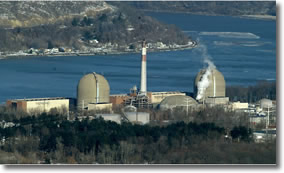 First-hand Experience
First-hand Experience
Reactors are one of those things with which I have plenty of first-hand experience.
In the Navy, for example, I literally *lived* with a reactor .. while stationed aboard a nuclear-powered ballistic-missile submarine, home-ported in Pearl Harbor, Hawaii (.. with the Dog) for a few years.
In commercial nuclear power, I might as well have lived there. I've worked at a handful of different plants around the country .. as a migrant nuclear worker of sorts.
I've worked at both pressurized and boiling water reactor plants. (I prefer PWRs, as I think do most rad ho's.) On both the East & West coasts.
I have been to the nasty-of-nasties (highest dose areas) .. in both PWR & BWR plants. Which is why I have a lifetime occupational exposure record with respectable numbers (.. selling my body for $Rad dollars).
[ Dont think I wasnt a little concerned when the Bug was born .. but he came out "perfect." Whew. ]
Meanwhile, military/Navy plants have no really nasty places (.. radiation-wise). You could literally eat lunch sitting on the reactor in your street clothes. (If they would let you. Which they dont.)
 » Ceramic Pellets Inside Long Metal Pins (Rods)
» Ceramic Pellets Inside Long Metal Pins (Rods)
Yeah, I know a little about reactor fuel cell construction. Tho that was never my focus. (Rather » plant operations & radiation protection.)
The military doesnt teach you how to build a reactor, just how to operate one.
They do however, teach enough so you know what kind of animal you're dealing with. From an operational perspective, you dont really need to know from-whence-the-beast-cometh. Only what it looks-like here-n-now.
But I picked up bits here & there .. along the way. Plus I ask lotsa questions.
A fuel cell is comprised of little pellets (dark gray), similar in size and shape to that of a thin cigarette filter .. like a long stick cut into small pieces, tho a little smaller and stubbier than a cigarette filter.
A bucket-load of these ceramic (uranium-containing) fuel pellets are fed into long pins (called "rods" by some) .. that are maybe 12-feet tall.
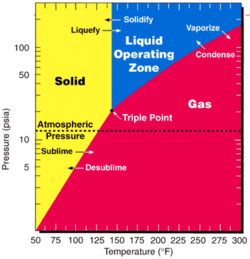 These pins are made of an exotic (metal) alloy .. specifically design to withstand the enormous heat and pressure that is generated when a reactor is operating at power (.. a truly beautiful thing, technologically speaking).
These pins are made of an exotic (metal) alloy .. specifically design to withstand the enormous heat and pressure that is generated when a reactor is operating at power (.. a truly beautiful thing, technologically speaking).
[ Uranium is classified as a METAL, but they (somehow) convert it into a GAS (Uranium hexafloride) .. during the production process .. in order to enrich it .. using centrifuges that spin at superfast speeds. More about enrichment later.
I'm no chemist, but the technology required to turn a super-heavy metal such as uranium into a gas .. seems very sophisticated. No? Modern alchemy. ]
 All of the fuel cells that I saw came in grids of 8-pins by 8-pins, for a total of 64 pins (i.e. "rods") per fuel assembly. (I hear there exist other configurations than the 8x8 variety.)
All of the fuel cells that I saw came in grids of 8-pins by 8-pins, for a total of 64 pins (i.e. "rods") per fuel assembly. (I hear there exist other configurations than the 8x8 variety.)
[ Many of the news articles that I read used the term 'fuel rods'. I have never heard that term used before. Rods were always control rods (discussed below).
So maybe they use a different reactor core construction in Japan. And I guess you could call these pins (that make up a fuel cell) 'rods'. But I wouldnt.
Intuitively, to me, a rod is round and a cell is square. Either way, melting nuclear fuel is very bad, no matter what terminology you use. ]
That glowing shaft pictured above is a single fuel cell. The average reactor core consists of maybe a thousand such assemblies .. tho these smaller, older reactors at Fukushima used half that many. I'm not certain, but I think the life of a fuel cell in a reactor core is ~3 to 5 years. Then it's 'spent'.
New fuel cells are first loaded at the outer edges of a reactor core (.. during a refueling outage, while the reactor is shutdown). During subsequent refueling outages, they are moved toward the inner areas, where the neutron flux is greater. The goal here is to try to provide an 'even' burn (uranium) across the core. No localized hot spots.
I never did find out how much each fuel assembly costs. I'd guess a quarter mil .. but if anybody knows for sure, my curiosity will thank you.
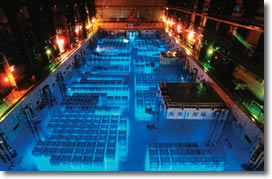 » Decay Heat & Reactor Scram
» Decay Heat & Reactor Scram
The problem with the reactors in Japan is » decay heat .. caused by radioactive decay of the fission products.
Newly-fissioned fragments are not 'happy' campers. They undergo radioactive decay vigorously and often, a process which gives off considerable heat (.. tho not nearly as much as the fission process itself).
This process of decay subsides with time, tho never stops (.. at least not for thousands of years).
First sign of a problem, the reactor operators are gonna perform a normal or expedited reactor shutdown.
In the case of a massive earthquake, I guess they would scram the reactor, which is like hitting a kill-switch .. that immediately sends all control rods IN (.. to the reactor core). A scram is the closest thing you get in nuclear power to a get-out-of-jail free card.
••• today's entry continues here below •••
[ Control rods (which are usually made of boron or hafnium) absorb neutrons, which tends to LOWER the fission rate, thereby lowering reactor power. Each fissioning atom gives off 2-to-3 neutrons, thus generating a self-sustaining chain reaction, when these neutron-absorbing rods are removed (pulled) from the core.
Hafnium is better, cuz it sucks up a lot more neutrons than boron, but it's also more expen$ive. Military plants use hafnium, commercial plants use boron. Each boron atom can only absorb 1 neutron and it's done, while each hafnium atom can suck up many neutrons. Six or seven, I think.
Boron can be added (as a powder) to the cooling water being pumped into a problem reactor. This will also lower reactivity and minimize the chance of unintended criticality (reactor start-up).
If you measure the mass of the fission fragments, you'll find that the sum of their parts weighs LESS THAN the original Uranium atom. What happened to the difference? That's called the mass defect. E=mc² .. in other words, a little mass has been turned into a LOT of energy. That's basically how we get energy from fission. ]
Scrams tend to cause significant physical shock to the system, so you dont want to scram unless you absolutely must.
Scrams kill reactor power .. like turning off your car. But the reactor core (.. the hundreds of individual fuel cells) will continue to produce lots of heat .. for some time to come. This heat must be removed. Or else. This heat (that continues to be produced after reactor shutdown) is called » decay heat.
[ At one time, the term SCRAM literally meant » Safety Control-Rod Axe-Man. That is a funny story in itself. Makes me think of the term 'bug' in computers. ]
 This heat dissipates with time (.. due to radioactive decay), but in the days immediately following high-power operations, there is lots of decay heat that must be removed .. especially since commercial reactors (unlike military reactors) normally operate at or near 100% reactor power.
This heat dissipates with time (.. due to radioactive decay), but in the days immediately following high-power operations, there is lots of decay heat that must be removed .. especially since commercial reactors (unlike military reactors) normally operate at or near 100% reactor power.
[ More power » produces more heat » produces more steam » more electricity (via spinning a steam-driven turbine coupled to an electrical generator) » more money » more profit$. ]
We had a whole LIST of alternate sources of auxiliary cooling .. in the case of a loss of power to the main coolant pumps. I mean, just about any liquid system could be configured to supply cooling the reactor core.
But you had to be able to get close to the reactor .. in order to manipulate valve line-ups. And if the suker is melting down, you aint getting close (.. unless you're a hero).
Management would consciously choose OLDER guys, who already had kids (possible genetic damage to 'nads/sperm) .. for theoretical emergency functions like this. Needed to sign a volunteer waiver affirming you understood the risks.
Easy to do during a drill. Fun to play the hero who will sacriface his life to save the plant when its only a practice drill.
The LAST thing on that list was SEAWATER using NATURAL CIRCULATION .. which suks, seeing all those chlorides in seawater (bad for corrosion .. chloride-pitting/stress/cracking corrosion), but hey, it worked. It would get rid of the decay heat and keep the reactor core from melting.
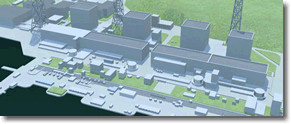 The use of seawater to cool a reactor means you're at the end of your rope. Cuz you got nothing else.
The use of seawater to cool a reactor means you're at the end of your rope. Cuz you got nothing else.
All other options have been exhausted. You're desperate and you know it. It's one last 'Hail Mary'.
[ Natural circulation happens because warmer water will rise, drawing cooler water in from the bottom. No pumps are used. Hence the term 'natural'.
A reactor cannot be run with chlorides in the coolant. Absolutely none. They cause a particularly nasty form of corrosion.
I ran reactor water chemistry in the Navy. That was one of my duties. We ran daily samples. A chloride titration was one of the dozen-or-so analyses we did (.. pH, gaseous activity, degassed activity, crud concentration, etc.). We could not have ANY detectable chlorides (<0.1 ppm). And we never did.
Every teaspoon of seawater contains zillions of chloride ions. (Table salt is nothing but crystalized sodium-chloride.) Perhaps it's possible to flush these chloride ions, but I dont see how it could be done. You're always gonna have some residual remaining.
In other words, any reactor that has been cooled with seawater will never run again. It has just produced its last mega-watt. No regulator is gonna let them restart a reactor with chlorides in the coolant.
That's why the use of seawater is seen as such a last-ditch act of nuclear desperation. You just trashed hundreds of millions of dollars worth of revenue-generating infrastructure.
Plus, once you lose core integrety you can never start that unit again. ]
The acronym 'LOCA' is used when discussing loss of coolant accidents. A LOCA is as bad as it gets for an operator. Once you lose core integrity it's pretty much all over for you. Time to place that call to Truckmasters Inc. "Breaker one-nine, good buddy. What's your twenty?"
 » Reactor Meltdown
» Reactor Meltdown
Meltdown occurs when the temperature of metal casing of the long pins that hold the (tiny) fuel pellets REACHES its melting point.
I dont think the ceramic fuel pellets ever actually melt. I think their melting point is far above that of the metal pins that hold them.
I think the magic number here is about 1,500 degrees F .. when the Zircaloy cladding will start to fail. (The article says 1,100 Kelvin, which = 1,500 F.)
The guy on TV said the cladding will melt at 2,100 degrees F. Okay, that sounds reasonable. Meltdown at 2,100 F.
If the control rods melt, that could get the chain reaction going again .. like during a reactor start-up, since "pulling rods" (out) is what you do when starting a reactor. That would be very bad. Time to leave. Later, dawg. Never thought about control rods melting before.
Tho if there was NO WATER to moderate (thermalize) neutrons, nothing would happen, since thermal neutrons are needed for fission, and water is what thermalizes neutrons (slows them down).
Because each water molecule contain two hydogen atoms. And a hydrogen nucleus = one solitary proton, which is nearly identical to the size & weight of a neutron. (A proton is like a neutron with a positive charge.)
[ I drank beers (years later) with guys who were there when TMI melted down. They told me that they knew something bad was gonna happen, cuz the company running it was "a bunch of clowns". ]
I will add that the Navy is all about safety, to a fanatical degree. Money is no object. While commercial nuclear stations need to temper safety concerns with profitability. I am not condemning here, merely stating an obvious difference.
You rarely hear about U.S. naval nuclear-powered vessels (submarines, aircraft carriers, etc.) in the news .. despite them logging many hours underway every year. There's a reason for that. The move from military to commercial can be a little jarring in this (safety) respect. (But you quickly get u$ed to it.)
 » Military vs Commercial Reactors
» Military vs Commercial Reactors
There is also a huge difference in the enrichment of military reactor fuel cells.
Typical commercial fuel cells are enriched ~5% (2-to-8) .. while military fuel cells are enriched to 95%.
[ Enrichment is the ratio of U-235 to total Uranium, including U-238. U-235 is the good stuff. Cuz it fissions more easily. But it's rare and very expensive to isolate (.. using centrifuge). Natural enrichment (found in nature) = less than 1% U-235. More than 99% = U-238.
The remaining U-238 is called depleted uranium, and is used to make armor-piecing bullets and other exotic ballistics. Uranium is very heavy. Dense. Makes lead feel light. ]
Whereas you need to refuel a commercial plant every 18-to-24 months, military reactors are good for the life of the ship (30-40 years). I've done many Commercial refueling$, yet I've never even heard of a military reactor being refueled.
That's what 95% enrichment does for you. The reactor never runs out of fuel. Nice. Super expen$ive. Commercial plants could never afford such a luxury. Only Uncle Sam with his unlimited checkbook.
 » Power Entries & Neutrons
» Power Entries & Neutrons
Normally, people arent allowed near the reactor during power operations. The door to the air-lock is bolted shut with multiple locks attached.
God's signature is required for entry (.. during power, while the reactor is running).
If an emergency entry is necessary under power (.. called a "power entry"), operations will first lower power. (Radiation levels are roughly proportional to reactor power.)
You get in-n-out fast as possible .. sometimes wearing a scuba, in lieu of an oxygen air sample. The job is well-planned .. down to "the gnat's ass". Everybody knows exactly what their job is. If anything unexpected is found, everybody comes out. You dont sit around near an operating reactor trying to figure out what to do next.
Most reactor containment buildings are inerted with nitrogen during operation to preclude the chance of fire. (Recall the three things necessary for combustion to occur.) Tho they will ventilate the containment building (the dome) for at least 15 minutes prior to entry.
The only time you encounter neutrons are during power entries. Neutrons go away completely when the reactor is shutdown. (We called them » 'trons).
I never much minded (getting exposed to) x-rays or gamma rays, since they are only (high-energy) light particles. But I never liked 'trons. Neutrons are little 'balls' that hit & whack (damage) your own little balls (neutrons & protons). Think » breaking a billiards rack.
It was an intuitive thing for me. Seeing either gammas or trons could kill you just as easily. Some guys claimed they could actually FEEL 'trons ( .. during power entries). "Dude," I said, "dont let anybody hear you say that." =)
But neutrons actually have MASS. Think about that a sec. They have physical mass. And they're moving wicked-fast.
For a given amount of radiation-energy deposited in your body, FAST neutrons do TEN times the biological damage of X-rays or gamma-rays. Thermal (slow) neutrons do HALF that damge (5X). See here.
In other words, neutrons (phyical particles) tend to do MORE DAMAGE than do light particles (photons = either x-rays or gamma rays). Not totally surprising, right?
The difference between X-rays & Gamma rays is just the source. X-rays come from the electrons, while gamma rays come from (the radioactive decays of) the nucleus. In general, gamma rays tend to be higher energy photons (light particles) than X-rays. Sometimes *much* higher.
That was back during the days when "the dome was my home".
Power entries were when you could really FEEL the power of a nuclear reactor. I mean, normally a reactor is shutdown whenever you're working around it (.. 99.9% of the time). But during power entries, the whole place (inside the containment dome) .. is humming, vibrating, roaring.
Lots of gigantic pumps running. Everybody is wearing double ear protection .. cuz the place is so loud. And it's hot inside .. even in the winter. And there's this smell. Like no other smell.
Comparable to a religious experience .. where you can feel God (power). The containment dome, with its high, arching ceiling, acting as a techno-cathedral.
Nothing like a leisurely power entry on a Sunday afternoon .. paying homage to the Tron god with your 'brothers' .. all of you wearing the yellow vestments of a devotee. =)
 » Keep It Covered
» Keep It Covered
So basically, the guys in Japan want to find a way to keep water flowing thru the reactor core .. to remove the decay heat.
As time goes on, decay heat will drop off. But the first few days will be the most critical. (It's like your engine immediately after you turn off your car.)
If they can make it 5 days without melting, without losing core intergrity .. I'd say they're over the hump.
That's the US$64K question » is the core covered? If not » hasta la vista, baby. No sense in even pretending you got a handle on it.
For most problems encountered in a nuclear plant, if the operator will simply take his hands off the control panel, the reactor will safely shut itself down. Reactors are well-designed with many redundantly redundant safety mechanisms built it.
It's when operators override protective functions that problems occur (.. like at TMI & Chernobyl) .. usually in the wee morning hours of the back-shift .. when most brains operate at reduced capacity. Tho this is obviously not the case at Fukushima.
Yet you can be sure they will be criticized for not doing more .. to ensure a reliable back-up power-supply .. to the main coolant pumps.
Let's be clear. The ability to provide cooling the core -- under any & all contingencies (.. yeah, even a 9.0 earthquake & its ensuing tsunami) -- is nuclear job #1. Cuz without that, you're just an accident waiting to happen.
The plant can fall apart, but you still need to be able to keep the core covered & cool.
Excuses tend not to go over well when the topic is related to anything nuclear. "Yes, absolutely," is the only response accepted. (True or not.)
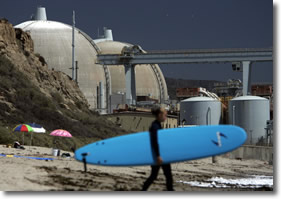 San Onofre sits close to the Newport-Inglewood fault, and could be affected by the San Andreas fault (according to Yuri). You can be sure folks will be asking some hard questions there.
San Onofre sits close to the Newport-Inglewood fault, and could be affected by the San Andreas fault (according to Yuri). You can be sure folks will be asking some hard questions there.
The plant manager of every nuclear plant in the world will now be required to reassess their "emergency-planning & preparedness," and submit a document swearing (in blood) to the ability of his plant to avoid a similar catastrophe .. co-signed by some reputable engineering firm.
[ Good time to buy stock in companies that make emergency diesel generators. Lots of upgrades are coming. Whatever company makes the DG considered most durable & reliable. Nuclear grade. This way a plant manager can claim he did something tangible.
I was a qualified diesel operator (.. in the Navy). Fairbanks-Morse 6-cyl, opposed-piston. I forget the power rating. Loud as hell. The whole place shook, vibrated. Made it hard to train a new guy, cuz you had to yell in his ear.
Fun to start. Had to use both hands and 1 foot .. to operate various switches and valves. Took some getting used to. Felt like a dang acrobat. Had to think about 3 things at once.
Started it rolling with 700-lb air. Felt like the thing was ready to come apart .. until it started. Then it ran smoothly. Purred.
Had to crank this dang manual oil prelube handle .. 127 times .. to prelube the bearings. Your arm would nearly off.
"Manuvering, Diesel. The diesel is prepared to snorkel."
"The diesel is prepared to snorkel, Manuvering, aye."
"Diesel, Manuvering. Commence snorkeling."
"Commence snorkeling. Diesel, aye."Rock-n-roll, baby.
If you forgot to unlock the kick-drain (before start-up), or had trouble getting it shut .. the whole compartment would quickly fill with smoke, soon as the diesel started. If you released the exhaust snorkel valve bypass too soon, the sucker would die. Both are embarrassing. Timing is everything.
The problem was .. you cant get water (from the submarine exhaust) flowing back into the cylinders .. before the diesel worked up enough pressure to push it out .. or the thing would break .. seeing how water doesnt compress very well. ]
The mistake people make when debating the merits nuclear power is to consider them in a vacuum. But you must evaluate the merits of nuclear power relative to other energy sources. Cuz nobody is gonna turn off their electricity. And every alternative source comes with its own set of disadvantages.
On the topic of radiation, the key number you wanna know is » LD 50/30, which is ~400 Rem (.. which = 4 Sieverts or 4,000 milliSieverts). LD = lethal dose. That's the dose at which 50% of the people exposed (half) will die within 30 days .. with no medical treatment. (With medical treatment, you could probably survive twice that dose.)
[ 1,000 milliSieverts = 100 Rem ]
As long as the fuel stays in the pressure vessel, nobody in Japan should get anywhere near that. Chernobyl did not a PV. Presure vessels are ~6-inches thick, metal. They surround the entire core. The PV is why more care is required to cool down a reactor plant than heat one up.
[ Small note: I heard people on TV referring to the pressure vessel (.. i.e. the 6-inch thick metal casing immediately surrounding the reactor core) as the "Containment Vessel'. I have never heard it called that. The term 'containment' was always reserved to refer to the large outer DOME .. in the case of a PWR.
The large outer BOX (.. that blew apart in Fukushima), I've always heard called "the reactor building".
But yes, different places use different terminologies .. which is why it's fun to work different plants .. to see how they do things. ]
A simple explanation of the problem is found in the 6 slides found here (BBC). Here's a more elaborate explanation (MSNBC video). More good multimedia here (NYTimes).
Looks like they have a boiling water reactor (BWR) at Fukushima. PWRs dont have steam coming out of the top of the pressure vessel like that. Yeah, see here. Six BWR's. Ugh, I hate BWR's.
Normally, when you see a dome, that's a PWR. When you see a big square box, that's a BWR.
 Anybody who has ever worked in a nuclear facility knows that hydrogen gas is much more scary than radiation. You cant even feel radiation.
Anybody who has ever worked in a nuclear facility knows that hydrogen gas is much more scary than radiation. You cant even feel radiation.
But hydrogen is wicked explosive. The slightest spark (such as flicking on a light switch) will blow your ass to kingdom come.
My ears always perked up whenever I heard the word 'hydrogen' mentioned in a pre-job briefing .. no matter how small the concentration.
[ There's a saying in the nuclear industry » dilution is the solution to pollution. ]
The problem with radioactive iodine (a fission fragment) .. is that your body cant tell the difference between the regular ('stable') iodine and the radioactive stuff.
That's why you wanna pre-load your thyroid with the stable stuff, so if you're exposed to the radioactive stuff, your body wont need any (iodine).
Radioactive Cesium-137 .. your body thinks this is postassium (think bananas). We called it 'Sneezium-137.'
So .. do I have a crystal ball? Did I sense a glitch in the matrix? Or was last month's post (& story) simply a curious coincidence?
It was a good story, and if I was ever gonna share it .. that would be the only place.
What would be *really* trippy is .. if that particular incident happened at the Fukushima plant.
Wanna know what I see ahead for the economy? Okay. Send US$5 to Rad Forecasts, PO Box .. Newport Beach, Calif... =)
Related » Nuclear Spent Fuel Pools DRY at Fukushima
For more along these lines, here's a Google search preconfigured for the query » nuclear reactor meltdown fukushima japan earthquake tsunami
